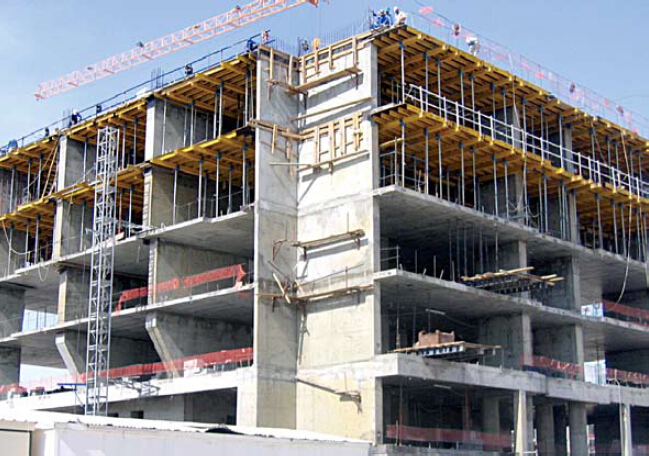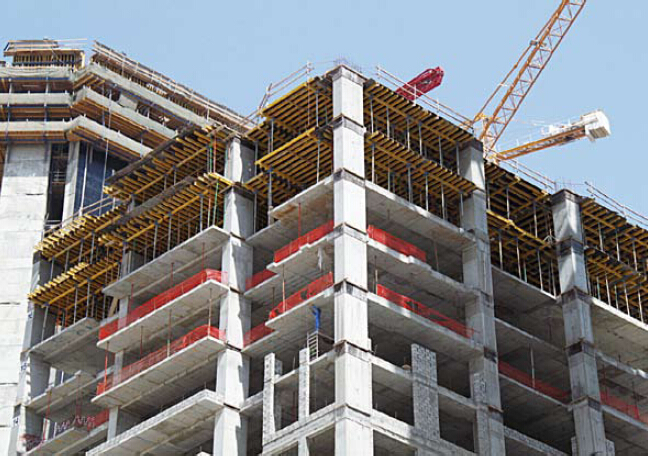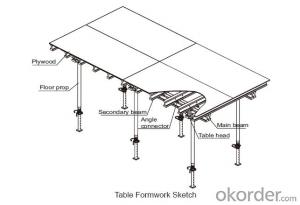Tabel Formwork Systems for Formwork and Scaffolding Build
- Loading Port:
- Tianjin
- Payment Terms:
- TT OR LC
- Min Order Qty:
- 50 m²
- Supply Capability:
- 1000 m²/month
OKorder Service Pledge
Quality Product, Order Online Tracking, Timely Delivery
OKorder Financial Service
Credit Rating, Credit Services, Credit Purchasing
You Might Also Like
Tabel Formwork:
Table formwork is the most typical application for slab, with timber beam, the slab formwork is
light weight, fast and economic in the construction.
Characteristics:
◆ Simple structure, easy assembly.
◆ Flexible structure, be adapted to different support system.
◆ High construction efficiency with special system tools.
1. Lifting fork for lifting the table formwork to upper floor.
2. Trolley for moving the table formwork on floor.
◆ Flexible application with stand alone props.
◆ Safer condition with handrails.



- Q:Can steel formwork be custom-made?
- Yes, steel formwork can be custom-made. Steel is a versatile material that can be easily shaped and welded to create formwork that meets specific project requirements. Custom-made steel formwork is often used in construction projects where standard formwork systems may not be suitable due to unique design elements or complex geometries. By customizing the steel formwork, construction companies can ensure that it fits perfectly, resulting in efficient and accurate concrete pouring, reducing waste and saving time and costs. Custom-made steel formwork also offers the advantage of durability and reusability, providing long-term benefits for multiple construction projects.
- Q:How does steel formwork affect the overall safety of a building project?
- Enhancing the overall safety of a building project is a crucial role that steel formwork plays. Its high strength and durability ensure a stable structure, preventing accidents such as collapses or structural failures that can cause serious injuries or fatalities. Furthermore, steel formwork offers a secure and dependable platform for workers. Its rigid structure minimizes the risks of slips, trips, and falls, which are common causes of accidents on construction sites. Additionally, safety features like handrails, guardrails, and non-slip surfaces can be incorporated into steel formwork designs, further enhancing worker safety. Another significant advantage of steel formwork is its fire-resistant properties. Unlike combustible materials, steel does not contribute to the spread of fire. This characteristic significantly reduces the potential for fire-related accidents, safeguarding both the workers and the structure itself. Moreover, steel formwork exhibits high resistance to adverse weather conditions, such as heavy winds, rain, or earthquakes. This resistance ensures the structure remains stable and secure even during extreme weather events, minimizing the risks of accidents or damage caused by these external factors. Lastly, steel formwork provides better quality control compared to other formwork materials. Its precise and consistent dimensions reduce the chances of errors or inconsistencies in the construction process, resulting in a safer and more reliable end product. In conclusion, steel formwork positively impacts the overall safety of a building project by providing stability, a secure working platform, fire resistance, weather resistance, and improved quality control. These factors collectively contribute to reducing the risks of accidents, injuries, and structural failures, making steel formwork an essential component in ensuring a safe construction environment.
- Q:What are the different types of bracing used with steel formwork?
- The stability and strength of the structure being formed are ensured through the utilization of various types of bracing with steel formwork. Each type serves a specific purpose in achieving this goal. 1. Diagonal Bracing: To prevent lateral movement of the formwork and provide stability, diagonal braces are employed. These braces are typically positioned at an angle between two corners of the formwork, creating an "X" shape. They assist in evenly distributing loads and resisting the forces acting on the structure. 2. Vertical Bracing: In order to support the formwork vertically and prevent sagging or bulging, vertical braces are utilized. These braces are usually installed at regular intervals along the height of the formwork, offering additional support and rigidity to the structure. 3. Horizontal Bracing: Horizontal braces are implemented to counteract the horizontal forces acting on the formwork. They are placed horizontally, typically at the top and bottom of the formwork or at specific intervals along its length. This provides stability and prevents deformation caused by external loads. 4. Tension Rod Bracing: Tension rods are employed to distribute loads and reinforce the formwork. Depending on the specific requirements of the structure, these rods are typically installed diagonally or horizontally. Tension rod bracing is especially effective in resisting excessive deflection and preventing the formwork from collapsing under heavy loads. 5. External Bracing: When additional support is necessary, especially in the face of high wind loads or other external forces, external bracing is used. These braces are usually positioned on the outer side of the formwork and are designed to offer extra stability and prevent deformations caused by external factors. 6. Tie Rods: To hold the formwork together and apply uniform pressure on the structure, tie rods are employed. These rods are commonly installed horizontally or vertically and are tightened with nuts to secure the formwork in place. Tie rods also aid in evenly distributing loads across the formwork, preventing bulging or deformation. In summary, the different types of bracing utilized with steel formwork play a vital role in ensuring the stability, strength, and integrity of the structure being formed. They work collectively to resist external forces, distribute loads evenly, and prevent deformations or failures during the construction process.
- Q:Are there any specific considerations for using steel formwork in earthquake-prone areas?
- In earthquake-prone areas, there are specific factors to consider when using steel formwork. Steel formwork is preferred in seismic regions due to its strength and durability. However, certain aspects need to be taken into account: 1. Flexibility is crucial. Steel formwork must be designed to withstand seismic forces and absorb and dissipate energy during an earthquake to minimize structural damage. 2. Connection details must be carefully engineered to ensure proper load transfer and resistance to seismic forces. Special attention should be given to joints and connections to prevent failure during an earthquake. 3. Additional reinforcement may be necessary to enhance the strength and stiffness of the steel formwork system. This can include extra steel bars, cross bracing, or diagonal struts to resist lateral forces. 4. Proper anchorage of the steel formwork is vital in earthquake-prone areas. It should be securely anchored to the foundation or structural elements to prevent displacement or movement during an earthquake. 5. Regular inspection and maintenance of the steel formwork system are essential in earthquake-prone areas. Any damage or wear should be promptly identified and repaired to maintain the system's integrity and stability. 6. Compliance with local building codes and regulations for seismic design is crucial. These codes provide guidelines and requirements for the design, installation, and use of formwork in earthquake-prone areas. By considering these specific factors, the use of steel formwork in earthquake-prone areas can enhance structural resilience and contribute to the overall safety and durability of construction projects.
- Q:Can steel formwork be used for both large and small-scale construction projects?
- Steel formwork is applicable to both large and small-scale construction projects, thanks to its durability, strength, and flexibility. Its versatility allows it to meet the diverse demands of construction projects. Both large and small-scale projects can benefit from its ease of customization and adjustment to meet specific requirements. Moreover, steel formwork's reusability contributes to its cost-effectiveness for both types of projects. Furthermore, it guarantees a smooth and high-quality finish for concrete structures, enhancing the desired aesthetic appeal of both large and small-scale construction projects.
- Q:What are the different safety precautions to be followed during steel formwork installation?
- Some of the safety precautions to be followed during steel formwork installation include wearing appropriate personal protective equipment such as hard hats, safety glasses, and steel toe boots. Ensuring that the work area is clear of any hazards or obstructions that could pose a tripping or falling hazard. Using proper lifting techniques and equipment when handling heavy steel formwork components to prevent injuries. Adhering to proper electrical safety procedures when working with power tools or equipment near electrical sources. Following manufacturer's instructions and guidelines for the proper installation and use of steel formwork. Regularly inspecting the formwork for any signs of damage or defects and addressing them promptly. Additionally, proper training and supervision of workers should be provided to ensure they are knowledgeable about and adhere to all safety precautions.
- Q:Can steel formwork be used in areas with extreme temperature variations?
- Steel formwork is indeed capable of being utilized in regions with significant temperature fluctuations. Thanks to its high strength-to-weight ratio and resistance to thermal changes, steel is well-suited for diverse conditions. It can endure both high and low temperatures without experiencing structural deformity or deterioration. Moreover, steel formwork delivers exceptional stability and durability, guaranteeing its ability to withstand the strain caused by extreme temperature fluctuations. However, it is crucial to take into account the effects of thermal expansion and contraction when employing steel formwork in areas with substantial temperature variations, as these factors may influence the precision of the formwork and the ultimate concrete structure. By considering proper design aspects and employing appropriate installation techniques, any potential issues arising from temperature variations can be effectively managed.
- Q:What is the standard thickness of steel formwork
- Pellicle is down; if there is no pellicle, there is a line below, the light on one side
- Q:What are the different types of formwork ties used in steel formwork?
- There are several different types of formwork ties that are commonly used in steel formwork systems. These ties are essential for holding the formwork panels together and ensuring the stability and strength of the formwork structure. 1. Wedge Tie: This is the most common type of formwork tie used in steel formwork. It consists of a wedge-shaped metal piece that is inserted into a hole in the formwork panel. The wedge is then tightened, creating a strong connection and holding the panels in place. 2. Pin and Wedge Tie: This type of tie consists of a pin and a wedge. The pin is inserted into a hole in the formwork panel and then the wedge is driven into the pin, creating a tight connection. 3. Wing Nut and Tie Rod: This tie system uses a wing nut and a tie rod to hold the formwork panels together. The tie rod is threaded through the panels and secured with a wing nut on each side. This type of tie allows for easy removal and reassembly of the formwork. 4. Coil Tie: A coil tie is a type of tie that is used when the formwork panels need to be secured to the steel reinforcement bars. The tie is threaded through the formwork panel and then wrapped around the reinforcement bar, creating a secure connection. 5. Flat Tie: Flat ties are used to connect the formwork panels in situations where the panels need to be secured tightly against each other. These ties are flat metal strips that are inserted into holes in the formwork panels and then tightened. These are just a few examples of the different types of formwork ties used in steel formwork systems. The choice of tie will depend on factors such as the specific formwork design, the load requirements, and the ease of installation and removal. It is important to select the appropriate tie system to ensure the stability and safety of the formwork structure.
- Q:Are there any specific quality control measures for steel formwork installation?
- Yes, there are specific quality control measures for steel formwork installation. These quality control measures are put in place to ensure that the steel formwork is installed correctly and meets the required standards. One of the key quality control measures is the inspection of the steel formwork before installation. This involves checking the formwork for any damages, defects, or deviations from the required specifications. Any issues found during the inspection should be addressed and resolved before proceeding with the installation. Another quality control measure is the verification of the dimensions and alignment of the steel formwork. This is done to ensure that the formwork is fabricated according to the required dimensions and that it is properly aligned with the structure. Inaccurate dimensions or misalignment can lead to problems during the concrete pouring process and can affect the quality of the final structure. Additionally, quality control measures include checking the stability and strength of the steel formwork. This involves verifying that the formwork is properly braced and supported to withstand the pressure exerted by the concrete. It is important to ensure that the formwork can handle the load without any deformation or failure. Furthermore, the installation process itself should be closely monitored to ensure compliance with the required procedures and standards. This includes checking that the formwork is securely fastened and that all connections are properly made. Any deviations from the installation procedures should be immediately addressed and corrected. Regular inspections and audits should be conducted throughout the installation process to track the progress and identify any potential issues. This allows for timely interventions and corrections, ensuring that the steel formwork installation meets the required quality standards. Overall, specific quality control measures for steel formwork installation are essential to ensure the integrity and safety of the structure. By implementing these measures, any potential issues or defects can be identified and resolved early on, minimizing the risk of costly rework or structural failures.
1. Manufacturer Overview |
|
|---|---|
| Location | |
| Year Established | |
| Annual Output Value | |
| Main Markets | |
| Company Certifications | |
2. Manufacturer Certificates |
|
|---|---|
| a) Certification Name | |
| Range | |
| Reference | |
| Validity Period | |
3. Manufacturer Capability |
|
|---|---|
| a)Trade Capacity | |
| Nearest Port | |
| Export Percentage | |
| No.of Employees in Trade Department | |
| Language Spoken: | |
| b)Factory Information | |
| Factory Size: | |
| No. of Production Lines | |
| Contract Manufacturing | |
| Product Price Range | |
Send your message to us
Tabel Formwork Systems for Formwork and Scaffolding Build
- Loading Port:
- Tianjin
- Payment Terms:
- TT OR LC
- Min Order Qty:
- 50 m²
- Supply Capability:
- 1000 m²/month
OKorder Service Pledge
Quality Product, Order Online Tracking, Timely Delivery
OKorder Financial Service
Credit Rating, Credit Services, Credit Purchasing
Similar products
New products
Hot products

























